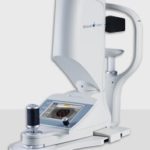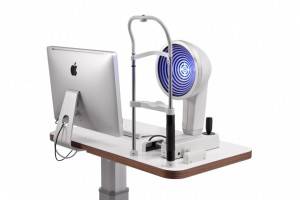Request Appointment
You can request your next appointment with us online!
Millennium Eye Center offers the most advanced diagnostic testing to ensure our patients receive the most thorough and complete eye exam possible.
Our team is ready to answer any question that you might have about your eye health. The following diagnostics are just some of the tests you’ll receive during your annual eye exam. Click HERE to schedule your exam or call us today at 407-292-9812!
 This instrument uses ultrasound to measure corneal thickness. Measurements of the cornea are significant in determining if you are a candidate for refractive laser surgery. Additionally, thin corneas can lead to falsely low pressure readings and thick corneas can lead to falsely high pressure readings. This test is done just once to create a baseline for future testing. Pachymetry may be needed if you are being considered for refractive corneal surgery or possibly glaucoma. The Oculus PARK 1® combines a non-contact pachymeter, auto-refractometer and keratometer in one unit. In addition to the objective refraction, the keratometer values and the pachymetry can be determined with precision in a matter of seconds with the PARK 1®
This instrument uses ultrasound to measure corneal thickness. Measurements of the cornea are significant in determining if you are a candidate for refractive laser surgery. Additionally, thin corneas can lead to falsely low pressure readings and thick corneas can lead to falsely high pressure readings. This test is done just once to create a baseline for future testing. Pachymetry may be needed if you are being considered for refractive corneal surgery or possibly glaucoma. The Oculus PARK 1® combines a non-contact pachymeter, auto-refractometer and keratometer in one unit. In addition to the objective refraction, the keratometer values and the pachymetry can be determined with precision in a matter of seconds with the PARK 1®
Your visual field is the area you are able to see in front of you without moving your eyes, including your side vision. There are several different methods of testing the visual field. Using a few different methods of testing, your vision is “mapped” to determine what you see at the edges (periphery) of your visual field. This helps to diagnose several conditions. The patient sits in front of a concave dome with a target in the center. The eye that is not being tested is covered. A button is provided to the patient to be used during the exam. The patient is asked to focus on the target at the center. The computer shines lights (of varying intensity) on the inside dome and the patient clicks the button when a light is seen. The computer automatically maps and calculates the visual field.
Amsler grid testing is often recommended for patients with macular diseases. The Amsler grid is an effective way for patients to monitor for changes in their central vision. Patients with significant macular disease are often advised to check the grid daily. The Amsler grid is simply a small square of graph paper with a dot in the center. Patients often apply the grid to a mirror, refrigerator, or some other prominent place in the house where they will see it and remember to check it daily.
A high- resolution digital camera attached to the Slit Lamp Microscope allows the doctor to have a permanent photo-image of the eye condition. This allows the doctor to manage external diseases and conditions of the eye. Digital images are used to compare progressive conditions of the eye to better determine treatment options. Conditions may include eyelid diseases, corneal ulcers, degenerations, and dystrophies.

The Oculus Keratograph® 5M is an advanced corneal topographer with a built-in real keratometer and a color camera optimized for external imaging. Unique features include examining the meibomian glands, non-invasive tear film break-up time and the tear meniscus height measurement and evaluating the lipid layer.
Optical Coherence Tomography (OCT) is a non-invasive imaging technology used to obtain high resolution cross-sectional images of the retina. This allows the doctor to see and measure very slight changes in the retina and optic nerve. The OCT uses light waves in a process similar to ultrasound to test for a number of retinal conditions, which could include glaucoma, Age-Related Macular Degeneration (AMD), post-cataract surgery edema, or other retinal changes. The OCT provides an extremely detailed understanding of retinal eye conditions and allows monitoring of treatment.
This non-invasive High Definition Photograph generates an instantaneous, digital image of the retina, revealing important information for the comprehensive evaluation of systemic and ocular health. It provides a permanent digital documentation, which allows accuracy in diagnosing disease of the retina and optic nerve. Provides the ability to measure progression of glaucoma and track the effectiveness of medications.
We now have the capability to offer to our patients the ability to Genetically test them for Macular degeneration. The test results will predict the probability of the patient to develop AMD (Age-related Macular Degeneration).